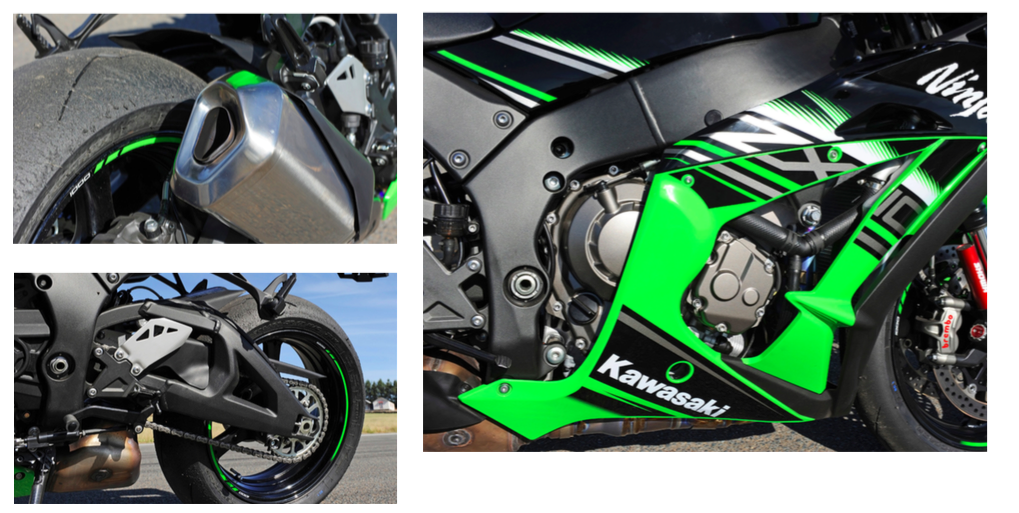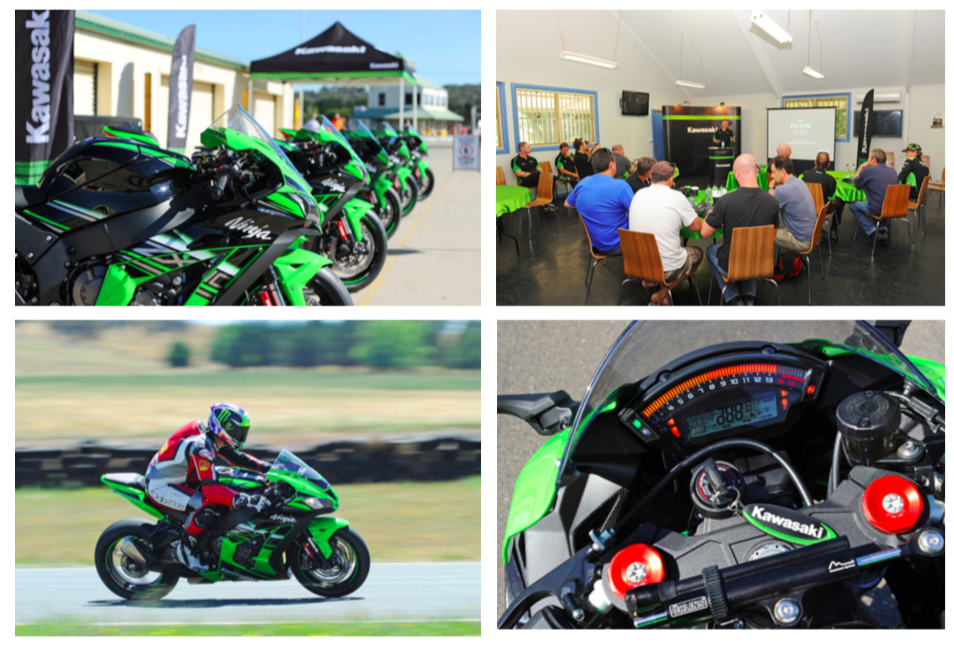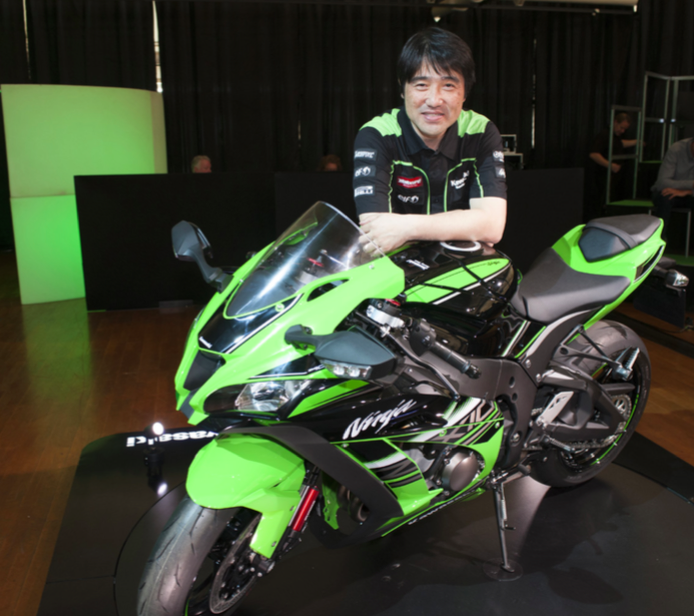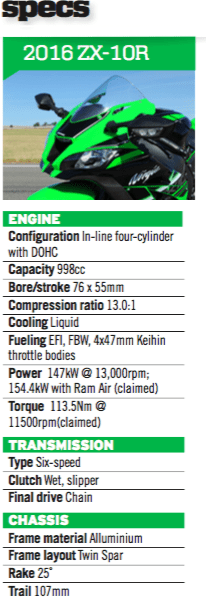Kawasaki enjoyed a very special year in 2013, the Japanese manufacturing giant achieving a feat it had only done once before in its long history of four-stroke racing motorcycles: Tom Sykes finally won the Superbike World Championship. It was the first WSBK title for Kawasaki since Scott Russell beat an army of Ducatis on his factory ZXR750 in 1993.
Sykes had come ever so close in 2012, finally missing out by half a point to Aprilia’s Roman Emperor Max Biaggi. However, his second place finish in what was his debut year sounded a warning to the competition of things to come. There was another second place in 2014, and then this year the fairy tale continued for Kawasaki as new recruit Jonathan Rea decimated the field on the 2015 version of the bike – essentially the same machine released four years before. On top of the successes at world level, the current Ninja has also become a popular trackday bike, roadbike, and even managed to win the 2015 Australian Superbike championships in the hands of Mike Jones. In its current form, the Kawasaki streetbike is pretty damn competitive and is still ticking all the right boxes.
Well mostly. There are a few shortcomings like a lack of ride-by-wire and a chassis that handles well but not quite as sweetly as some of the competition. And yet with all the success, why would Kawasaki build a new model? Considering that a normal run length nowadays ranges anywhere from five to six years (eight in the case of Honda’s CBR1000RR), it’s surely too soon at four years for a complete redesign. Instead, Kawasaki is taking its ZX10R supersport and superbike racing at the world level very seriously, and feeding the lessons learnt into the production model – and that’s good for us the consumers.
Which brings us to the launch of the 2016 ZSX-10R Ninja. Wakefield Park near Goulburn, NSW, was the setting for the event – a tight and bumpy circuit with a very short lap. It’s the kind of track that normally would be a lot of fun on a 600 or something smaller; bigger bikes are usually a handful as there is no straight to speak of and lots of hard braking. It was a brave move by Kawasaki Australia to even consider launching the ZX-10R here as it would have been easy for all the journalists on the day to give the bike a bad rap if it was a beast.
I have to say I was pumped to see the bikes in KRT colour scheme sitting in pitlane in the morning. I had read the entire blurb and had even ridden a superstock 2015 model earlier in the year, so I was interested in many aspects of this new bike. After the usual run-down speech and sign-on we were given four 15-minute sessions around the tight circuit. Sitting on the bike for the first time I felt comfortable, with all the levers falling to hand easily. Looking forwards, it seemed strange that Kawasaki didn’t use the latest Thin Film Technology (TFT) dash as fitted to the new Yamaha and Panigale, but to be fair, the dash is large and the tacho, which is the main point of interest on these sportsbikes, was actually easier to read than on a bike fitted with a TFT dash.
Heading out on track, the first thing that impressed me was the front fork. Showa and Kawasaki have been collaborating for years now and the 2015 Balance Free Front fork really does work like a factory superbike item. The feel and feedback was very high quality, just as you would expect on a racebike. I was especially impressed as this circuit is notorious for bumps and dips that can cause suspension chaos. The rear shock is smaller and lighter than last year’s, but it works well backing up the factory feel provided by the fork.
Initially I felt the rear shock was a bit soft and the rear needed to be stiffened up. Normally you would fix that problem by adding some preload, but due to time restrictions we added a couple of clicks of compression for my next outing. I was really impressed with the change. Two clicks improved the situation dramatically and gave me a new respect for the suspenders on this bike.
The other big news this year is the fitment of the ride-by-wire system, which opens the door to a bevvy of extra gadgets to play with. Kawasaki uses a Mitsubishi ECU loaded with software developed in house as the brains behind the brawn. And it does its job well – the throttle connection from hand to butterfly was near the best I have felt on a standard motorcycle equipped with ride-by-wire. In a world of completely adjustable motorcycles I would have given a little more response on full lean angle on the first touch of the throttle, but I’m being ultra-critical here. The ride-by-wire also helps adjust engine braking by matching wheel speed to road speed under deceleration. This definitely works and can be infinitely adjusted when you buy the ECU from the race kit. Mere mortals will be happy with the standard set-up though, which gives a choice of on or off with the two choices to suit track or rider style. For the tight, low-speed Wakefield Park circuit I turned it off to allow a bit more engine braking to pull me into the tight corners.

Kawasaki claims that the new Ninja has more power than last year’s – an impressive 154kW with ram-air assistance. It was hard to truly judge the speed of the ZX-10R on the day due to the size of the track, but it is certainly an easy power to use and that normally means fast. There are three power modes (60, 80 or 100 per cent power) which could be useful on the road or in rainy conditions. Wheelie control has also been massively improved compared to the old model and works as well as I’ve experienced on any superbike in the past – no wheelies, just pure acceleration allowing the rider to concentrate more on racing rather than controlling the bike.
The Traction control is also top notch. Unlike other systems on the market that work to preset targets fed in to the computer at the factory, this Kawasaki-developed system is self-adjusting to tyre wear, size and track-grip levels. It’s like having a factory system with a couple of technicians on board changing the settings corner by corner just like WSBK.
We rode the non-ABS model so I can’t comment on that aspect, but the stoppers are sensational. You could race in the Australian Superbike Championships with these stoppers as they are and not change a thing. On the front the lever feel gives the rider confidence, and thanks to the quality of the system provides excellent stability. Once I set my lever position I didn’t need to adjust it again for the remainder of the test. The rear was just as good. It was very easy to avoid rear locking, my major bugbear when it comes to rear brakes.
All of the above is great, but probably the most important aspect of any bike is its chassis. It’s all new this year and changed to improve bump absorption and weight positioning. I have to say that it’s a big improvement over last year, making the new bike feel like a 600 in its handling, and this was bought to the fore by the tight nature of the circuit. It gave me the confidence to place the bike where I wanted without worrying about the consequences. The other major attribute of the 2016 Ninja is its stability. The bike maintained its composure on new and old tyres, even even when my body positioning was wrong.
After my four sessions on the new Ninja I gained a new respect for ZX-10R creator Yoshimoto Matsuda, and his development team. This new bike is a massive improvement on a machine that was already a multi-championship winner. It certainly won’t take much to turn it into a very fast trackday bike straight off the showroom floor … perhaps just a set of tyres.

Thank you Dorna
In the Flamini years the regulations for WSBK drifted away from the original ideal, which was to buy a bike, put a pipe and some tyres on it, and go racing. Every year the bikes became more focused and racetrack orientated; myriad changes were allowed, essentially removing any mechanical resemblance between the racebikes and their homologated street equivalents. Different frames with different pivots, angles and thicknesses, ride-by-wire systems fitted to bikes that don’t come with it standard, taking a ton of weight off the crankshaft when you weren’t really allowed to … and so on. The bikes were more like GP bikes than streetbikes, and officials were lax when it came to policing the rules.
Since Dorna took over the role of WSBK promoter we have seen a lot changes to machine regulations in the series. In an endeavour to create a gap between MotoGP and the production-based class of superbikes, Dorna started enforcing the rules in place at the start of its reign, and giving a stiff warning to teams and manufacturers: obey the rules or accept the penalty. I remember being at the Nürburgring in Germany when the scrutineers started requesting that bikes from the top teams be pulled down after the races for crankshaft weigh-ins. There were a lot of worried looking Team Managers that day, and I believe many warnings were handed out.
One regulation that will be changing for 2016 is the fly-by-wire rule. As it currently stands, if your bike doesn’t have FBW standard you can’t fit it to race in the series: no FBW standard, no use. Kawasaki is one of the few companies that has shunned MotoGP and all its glory, instead putting its money and development power to good effect in WSBK and perfecting its road-going machine. But if you look carefully the current 2015 Ninja, it doesn’t have FBW, it doesn’t have the preferred frame that they use in WSBK, and the crank is heavy. Before I even ride the 2016 ZX-10R I know it’s going to be better than the current bike, and by a pretty big margin. The changes made on the new model replicate the full-blown race specs of the Flamini era.
Meet the maker
Things were looking dire for Kawasaki at the end of 2008. Having been involved in the premier class of MotoGP racing since 2003, the numbers just weren’t adding up. KHI was spending a reported $40 million a year on its GP effort, and with a global financial crisis looming the decision was made to pull out, effective immediately. That left riders John Hopkins and Marco Melandri in a quandary for the ’09 season, but they weren’t the only ones. A plethora of KHI staff were left jobless, including MotoGP Project Leader Yoshimoto Matsuda. After a few meetings and a new job description, Matsuda-san was given the task of creating a competitive ZX-10R, and went about it by turning a racebike into a streetbike – a first for a Japanese company. At his first attempt, with his first model, he won the Riders and Manufacturers Championship.

AMCN spoke with Matsuda-san and asked him a few questions…
AMCN: With the success of the previous model and I guess its newness, why did Kawasaki feel the need to bring out another bike that is essentially 100 per cent new.
Matsuda: The new bike is part of our company objective, to be simply the fastest on track. Since we stopped MotoGP back in 2007 we have been changing direction to make a bike for the people. World Superbike is the platform we chose to showcase and develop an easy to ride bike which can win but also give all level of riders a great sense of satisfaction.
AMCN Is it fair to say that we are seeing this bike due to tighter regulations being introduced in to the World Championship in 2016.
Matsuda: Yes, that is part of the reason, but we have also discovered in our track testing program that a good competitive racebike makes a great roadbike. We didn’t even test this bike on the road until the last moments, which had a lot of people in our company worried. In the end when we did take the new ZX-10R to the streets the worry disappeared.
AMCN: In your opinion what the biggest difference between this new bike and last year’s model.
Matsuda: It’s difficult because it’s better everywhere. I would say the handling. It’s not just one thing though, as a combination of all changes from electronics, engine, chassis and suspension all add together to make this bike lighter and more stable. In our back-to-back testing between the old model and new model there is a significant improvement in lap time between the two bikes.
AMCN: The quality of components seems extremely high this year.
Matsuda: Yes, I spent too many dollars and probably more than I should, but it was important to me to give the normal rider the best equipment. Apart from the Brembo Brakes, electronic Öhlin’s damper and the new Showa suspension, there are a lot of small but significant changes that people don’t really see. Take the brake lines for example, we use race quality braided lines, and another example are the header pipes, we use the high quality titanium as used by Akropovic and are the only company to do so.
AMCN: The last model ZX-10R was launched in 2011. Why did it take so long to update it, considering all the other ground-breaking sportsbikes that have entered the marked since then?
Yoshimoto Matsuda: We believed the last model was still competitive – which is evidenced by our World Superbike results. We didn’t want to rush it and wanted to wait for the perfect time to introduce the new model.
AMCN: Yoshimoto Matsuda, which component took the longest to design?
Yoshimoto Matsuda: Perhaps it was the Showa suspension. We made a corporate development with World Superbike – this is true development with Showa – and in the end on the inside it’s almost the same as the racebike’s.
From the beginning of the development period, there were three stages, including pre-production and production, and we had about 20 different suspension units for each stage – so we easily had over 60 designs in the end!
AMCN: What single design feature are you the proudest of?
Yoshimoto Matsuda: We have a resonance system inside the frame, which the previous bike didn’t have. That’s one of the unique ways we have reduced acceleration (intake) noise. It’s really nice because you can’t see this from the outside, just from the inside.
AMCN: What did you agonize over the most?
Yoshimoto Matsuda: While making the Showa suspension, we had lots of big discussions about what colour we should make the cartridge suspension. We had colours like red, green and silver – but ended up going with black.
AMCN: What do you think is the future for bikes? Were do you see the industry in 10 years?
Yoshimoto Matsuda: I spent four years developing an electric motorcycle. Many people love the engine – as do I. An electric motorcyle is so nice and so fast, but the market will decide in the years to come. If the market grows, we’ll grow. But if the market doesn’t want it, maybe we won’t go there.
The Ninja’s new weapons
1 New chassis
The steering head has been moved rearward in the steering stock, putting more weight on the front wheel as the modified factory frame was in 2014. The headstock and swingarm pivot is adjustable with collars available from the race kit.
2 New Bosch IMU
It may be small but this little black box takes the ZX-10R to the next level in electronic control. Essentially the Inertial Measurement Unit (IMU) can calculate bike position three dimensionally and send the information to the ECU so the correct engine management options can be delivered.
3 New Öhlins electronic steering damper
Varies stiffness and self-adjusts depending on acceleration force, deceleration force and road speed.
4 New high-vis instrumentation
LED Instruments with a light sensor to automatically adjust the light level brightness.
5 New KQS (Kawasaki Quick Shift)
Allows full throttle clutchless upshifts by ignition cut from the load sensor attached to the gearlever.
6 New upper cowl
Larger, taking wind pressure from the rider and increasing aerodynamics, comfort and speed.
7 New Showa Balance Free Front fork
Makes its world debut on the ZX-10R. It allows more controlled rebound and compression damping while keeping a more constant internal pressure, which also reduces cavitating of the oil.
8 New Brembo M50 calipers
The braking system is second to none this year with the Monobloc M50 calipers mated to massive 330mm discs and a Brembo radial master cylinder mated to braided lines to top the package off.
9 New Kawasaki engine brake control
Making use of the new electronic butterflies, engine braking back torque is adjustable and much more refined in the 2016 model.
10 Choice of three power modes
Gives you the option of full power (100 per cent), middle power (80 per cent) or low power (a scant 60 per cent).
11 New Electronic Throttle valve (ETV)
Has to be close to the most important change for 2016. It allows all other functions to work properly including the tricky Bosch IMU. You can’t feel them while you ride but those butterflies hardly ever follow the trace of the twist grip.
12 New titanium pipe
The trick to this new system is that the headers are very close to a race system, meaning that a slip-on muffler will be all has to be added instead of the usual full race system in most cases.
13 New swingarm,
Is longer by 15.8mm and with a changed rigidity gives more feel to the rider in braking, acceleration and change of direction.
14 New Showa BFRC (Balance Free Rear Chamber) rear shock
Lighter and more compact than the previous model with improved performance and feel.
15 Kawasaki Launch Control Mode (KLCM)
The IMU and the electronic throttle valve work in unison to measure front wheel lift and torque values, adjusting the power delivery accordingly for the perfect launch.
16 New Sport Kawasaki Traction control (S KTRC)
With five levels of adjustment and using inputs from the IMU and ETV, finally the ZX-10R has a traction control system rivalling the best in class.
17 Engine
Highly modified from 2015 with a lighter crank, new shorter pistons, bigger inlet valves, straighter polished ports, lighter chrome-moly camshafts and increased water jacket size the notable improvements.
Meet the racer
We chat to the guys using the Ninja at the pointy end of world competition
Jonathan Rea
His 23 podium finishes for this year eclipsed the record set by Troy Bayliss in 2002. The 28-year-old Brit ended up with 548 points, the seconds highest in WSBK history and a massive 132 points ahead of his nearest rival Chaz Davies.
Pere Riba
Jonathan Rea’s crew chief
The Spaniard raced in the World Supersport Championship from 2003 – 2007 and was previously crew chief for Joan Lascorz and Loris Baz. His favourite racetrack is Phillip Island and his childhood hero was Mick Doohan, which males him an honorary Australian
AMCN: What was the standout feature during your first taste of the 2016 bike at Aragon?
Jonathan Rea: I noticed straight away the riding position was much nicer compared to the previous model – especially with the new fork and new Brembo brakes. It was very much like my racing bike. It was also an improvement on some of the main issues we had been having on my racebike, like changing direction.
AMCN: Are roadbikes getting too powerful?
Pere Riba: The market for these bikes is more technology – because who is going to buy it? To just ride on a normal road every day this type of bike is not the best bike. This is a very racy bike. Every year we have more power and every year we have better control of this power. I believe it’s better to have 220 horsepower in 2015 than 170 horsepower in 2000, because now you can control the power.
For example in WSBK we now have 240hp. You know how many times on a racetrack that’s 5km long you use 240hp? It’s nearly never – because from first through to fourth gear the bike will be always wheelying. Maybe you can use full power in sixth gear at Motorland Aragon. The most important thing now in racing, including MotoGP, is how to control the power with the electronics.
As an example this year in WSBK we have 20hp less than last year and we broke 90 per cent of the records for total race time compared to last year. Power is not everything. Honda in MotoGP makes engines which are really strong and they cannot manage. Márquez is crashing because he is over the limit.
AMCN: Jonathan, It must have been nice to have been so involved with the 2016 model’s development.
Jonathan Rea: Yeah, the new bike has addressed many of the problems we had and it’s a huge step forward in technology. I rode the bike in Portimao last month and the development that’s gone into the production bike is super-good for us as a race model. Because the bike’s quite different, we need a good winter test to understand the balance of the bike and to get comfortable on it. After that we will make a step forward with the performance.
If you put the new and previous model next to each other, you can see the front fairing’s completely different, the rear seat unit, the chassis, inside the engine with a lighter crank, and that’s really going to help us with the racebike.
AMCN: Jonathan, the crankshaft has a 20 percent lower inertia. What does this mean for you as a rider?
Jonathan Rea: Inertia is like a weight inside the engine – like the crankshaft and moving parts – and when you’re accelerating the lighter inertia means more acceleration. Also when you’re trying to slow down, a heavier inertia – with the gyro effects – means it’s going to take you a longer time to change direction. With light inertia we can also stop the bike better on the way into a corner.
We’re on the right road to make a better racebike. We need to put it into our race trim and see how it works on the track – because while we’ve tested some parts separately in the race after Jerez, we really need to test the whole package together to see how it works.
AMCN: Would you like to see Kawasaki compete in MotoGP again?
Pere Riba: Of course – and for one major reason: MotoGP is free. You can do almost whatever you want. Chassis-wise you can do whatever you want and you can also do a lot to the engine. In WSBK we have a base – in which you can change a bit, but you cannot cross some lines. This means in MotoGP you have more tools and here we have less, so it’s more interesting.

WORDS STEVE MARTIN AND OSCAR KORNYEI PHOTOGRAPHY KEITH MUIR, OSCAR KORNYEI & KAWASAKI













